Jeep Wagoneer (2022 year). Manual in english — page 3
GETTING TO KNOW YOUR VEHICLE
45
(Continued)
When either the (+) or the (–) switch is pushed, the
Front Comfort And Convenience Display
page 72 will change to the Seat menu. The last
selected seat item of lumbar in/out, lumbar up/
down, back bolster, or thigh bolster will be
retained. Select the desired adjustment type, and
then press the (+) or (–) switch to adjust.
NOTE:
If the Front Comfort And Convenience Display is in
the stowed position, the Seat menu will display on
the main Uconnect screen.
Easy Entry/Exit Seat — If Equipped
This feature provides automatic driver seat
positioning to enhance driver mobility when
entering and exiting the vehicle.
The distance the driver seat moves depends on
where you have the driver seat positioned when
you place the vehicle’s ignition in the OFF position.
When you place the vehicle’s ignition in the OFF
position, the driver seat will move about
2.4 inches (6 cm) rearward if the driver seat posi
-
tion is greater than or equal to 2.7 inches (7 cm)
forward of the rear stop. The seat will return to its
previously set position when you place the
vehicle’s ignition in the ON/RUN position.
The Easy Entry/Easy Exit feature is disabled
when the driver seat position is less than 0.9 of
an inch (2.3 cm) forward of the rear stop. At this
position, there is no benefit to the driver by
moving the seat for Easy Exit or Easy Entry.
When enabled in Uconnect Settings, Easy Entry
and Easy Exit positions are stored in each memory
NOTE:
The Easy Entry/Exit feature is not enabled when
the vehicle is delivered from the factory. The Easy
Entry/Exit feature is enabled or disabled through
the programmable features in the Uconnect
P
OWER
A
DJUSTMENT
(R
EAR
S
EATS
) —
I
F
E
QUIPPED
Third Row Power Recline — If Equipped
If equipped, the power recline switch for the third
row seats is located on the trim panel next to the
seat. This switch adjusts the seatback angle
forward/rearward for occupant comfort.
WARNING!
Adjusting a seat while driving may be
dangerous. Moving a seat while driving could
result in loss of control which could cause a
collision and serious injury or death.
Seats should be adjusted before fastening the
seat belts and while the vehicle is parked.
Serious injury or death could result from a
poorly adjusted seat belt.
Do not ride with the seatback reclined so that
the shoulder belt is no longer resting against
your chest. In a collision you could slide under
the seat belt, which could result in serious
injury or death.
Do not place the seat belt webbing behind the
third row stow clip when using the seat belt to
restrain an occupant. The seat belt will not be
positioned properly on the occupant and they
could be more seriously injured in an accident
as a result.
CAUTION!
Do not place any article under a power seat or
impede its ability to move as it may cause
damage to the seat controls. Seat travel may
become limited if movement is stopped by an
obstruction in the seat's path.
WARNING!
2

46
GETTING TO KNOW YOUR VEHICLE
Third Row Power Recline Switch
The angle of the seatback can be adjusted forward
or rearward. Push and hold the forward or rearward
button. The seat will move in the direction of the
button push. Release the button when the desired
position is released.
Rear Seat Power Folding Seatbacks —
If Equipped
A one-touch power folding seat switch is located in
the right rear trim panel inside the cargo area, as
part of a switch bank.
The switch bank allows multiple power folding
positions for the second and third row seats.
The second row seats can be folded using these
switches, while the third row can be folded or
unfolded.
NOTE:
The third row seat belts may interfere with the
power folding of the seat. Place the seat belt
webbing behind the stow clip before stowing or
opening the seat. When the seat is in the desired
position, remove the webbing from the stow clip so
that it is ready for use. Never leave the seat belt in
the stow clip when it is used to restrain an
occupant.
NOTE:
The head restraints will lower automatically as
necessary when the power seat begins to move
The head restraint can also be lowered manu
-
ally using the pull strap located at the back of
the seat.
Rear Panel Power Switch Bank
There are also power folding switches for the third
row seats located on the C-pillar (just behind the
rear doors on the trim panels).
1 — Second Row Left Side Fold
2 — Second Row Right Side Fold
3 — Third Row Left Side Fold/Unfold
4 — Third Row Right Side Fold/Unfold
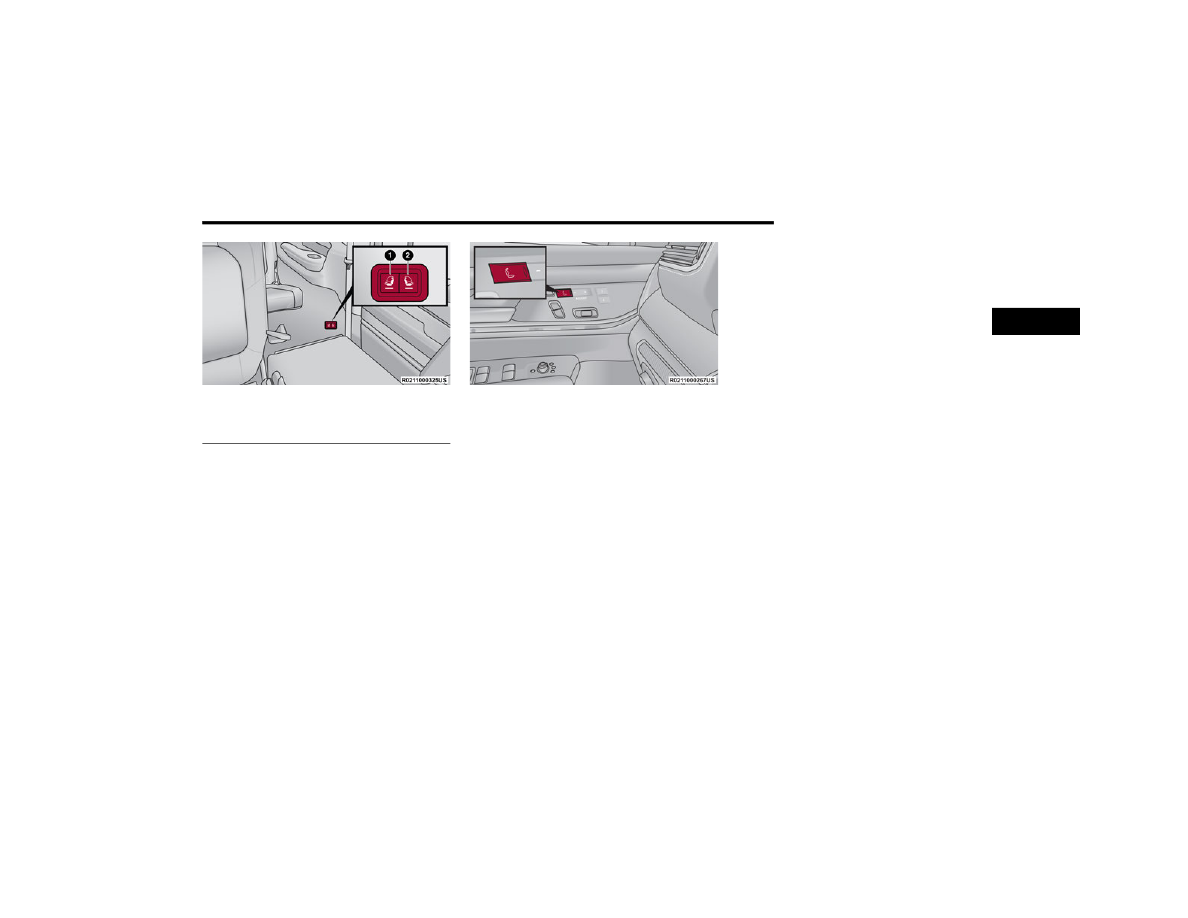
GETTING TO KNOW YOUR VEHICLE
47
C-Pillar Power Folding Switches (Left Side Shown)
P
OWER
S
EAT
M
ASSAGE
— I
F
E
QUIPPED
In Grand Wagoneer models, the driver’s and front
passenger’s seats may be equipped with power
massage.
The seat massage feature can be turned on/off
through the massage button located on the door
panel near the handle, or through the Controls
menu on the radio screen.
Door Panel Massage Button
Once activated by either method, the massage
controls screen will display on the Front Comfort
page 72, or on the
standard Uconnect display if the Front Comfort And
Convenience Display is stowed. “Massage Type”
and “Intensity Level” can be selected for the
activated seat.
There are four intensity levels and five massage
types that can be selected.
Intensity Levels:
High
Med
Low
Off
Massage Types:
Waterfall
Lower Back
Extend
Low Extend
Rock Climb
The massage type and intensity level status will be
synchronized between the main Uconnect display
and the Front Comfort and Convenience Display.
The selected settings will save in the system’s
memory when turned off, and will resume the next
time the system is turned on.
NOTE:
For vehicles equipped with a selectable back/
cushion feature for massage seats, the
massage feature can be deselected for either
the seatback or seat cushion. If both options are
deselected, massage will turn off.
Power seat massage is only available with the
ignition in the ON/RUN position.
The massage feature will turn off after
20 minutes of use. However, if the massage
type or intensity level is changed, the timer then
resets.
1 — Third Row Left Side Fold/Unfold
2 — Third Row Right Side Fold/Unfold
2
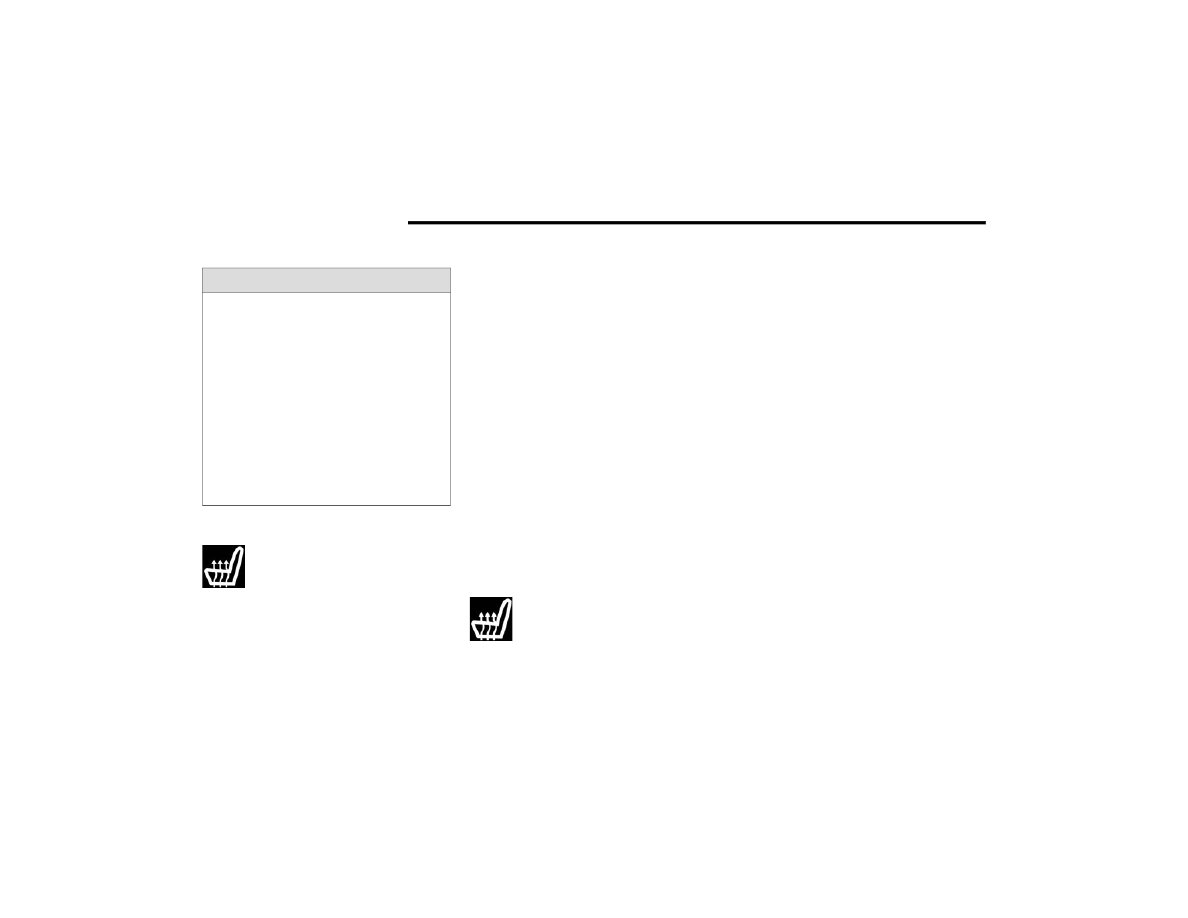
48
GETTING TO KNOW YOUR VEHICLE
H
EATED
S
EATS
— I
F
E
QUIPPED
Front Heated Seats
The front heated seats control buttons
are located on the sides of the radio or
within the Uconnect system. You can
access the controls through the Climate
screen.
Press the heated seat button once to turn the HI
setting on.
Press the heated seat button a second time to
turn the MED setting on.
Press the heated seat button a third time to turn
the LO setting on.
Press the heated seat button a fourth time to
turn the heating elements off.
The heating elements can be turned on in the
seatback only, seat cushion only, or both. Press the
seat image on the touchscreen or push the seat
zone button on the side of the radio to cycle
through these seat zones. An LED will illuminate
next to the selected zone(s). If equipped with
touchscreen buttons, the selected zones will be
highlighted on the seat image.
NOTE:
Once a heat setting is selected, heat will be felt
within two to five minutes.
The engine must be running for the heated
seats to operate.
The level of heat selected will stay on until the
operator changes it.
For information on use with the Remote Start
Rear Heated Seats — If Equipped
The two second row outboard seats may
be equipped with heated seats. There are
two heated seat switches that allow the
rear passengers to operate the seats
independently. The heated seat switches for each
heater are located on the rear of the center console.
If equipped with a Rear Comfort And Convenience
Display, heated seat settings can be selected
You can choose from HI, MED, LO, or OFF heat
settings. Indicator lights in each switch illuminate
indicating the level of heat in use.
Push the heated seat switch once to turn the HI
setting on.
Push the heated seat switch a second time to
turn the MED setting on.
Push the heated seat switch a third time to turn
the LO setting on.
Push the heated seat switch a fourth time to
turn the heating elements off.
The level of heat selected will stay on until the
operator changes it.
NOTE:
The engine must be running for the heated seats to
operate.
V
ENTILATED
S
EATS
— I
F
E
QUIPPED
Located in the seat cushion and seatback are fans
that draw the air from the passenger compartment
and move air through fine perforations in the seat
cover to help keep the occupant cooler in higher
ambient temperatures.
WARNING!
Persons who are unable to feel pain to the
skin because of advanced age, chronic illness,
diabetes, spinal cord injury, medication,
alcohol use, exhaustion or other physical
condition must exercise care when using the
seat heater. It may cause burns even at low
temperatures, especially if used for long
periods of time.
Do not place anything on the seat or seatback
that insulates against heat, such as a blanket
or cushion. This may cause the seat heater to
overheat. Sitting in a seat that has been over
-
heated could cause serious burns due to the
increased surface temperature of the seat.
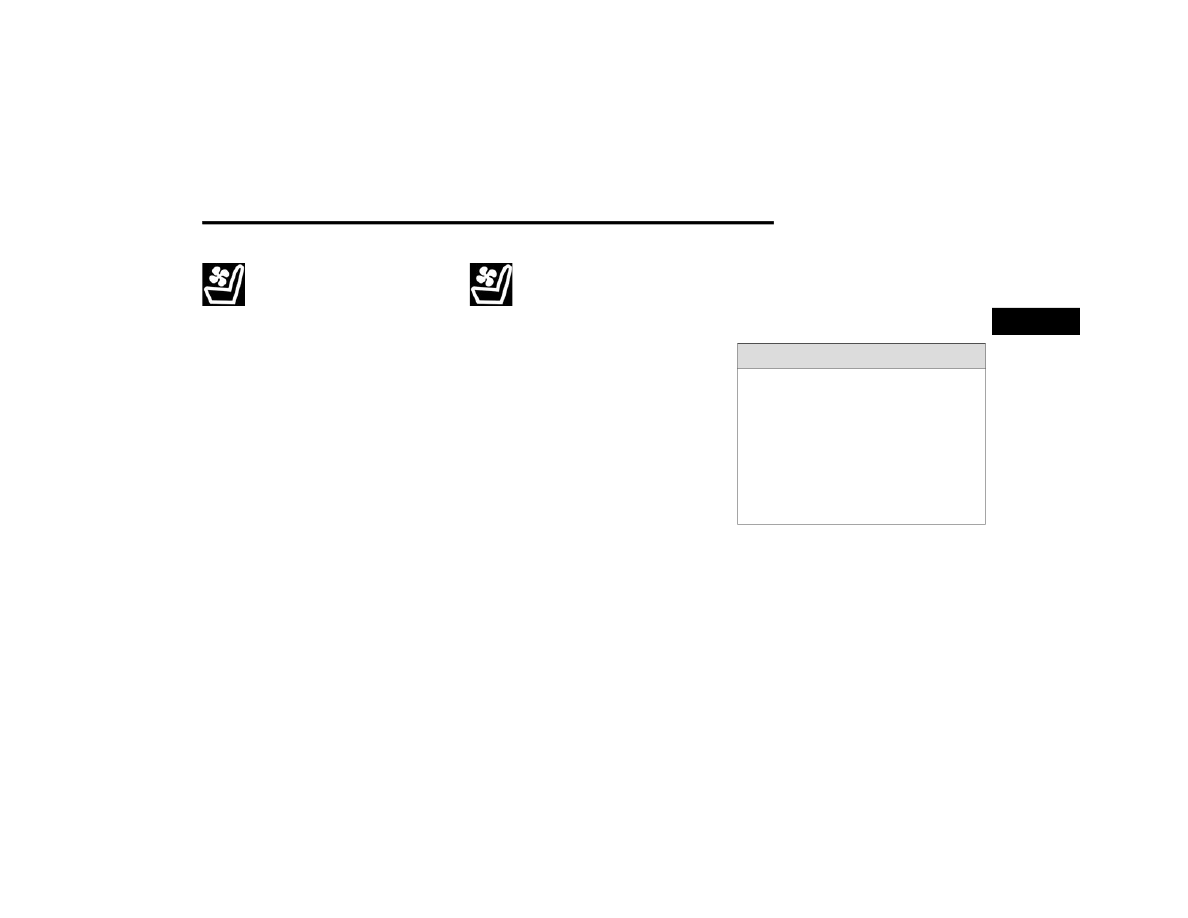
GETTING TO KNOW YOUR VEHICLE
49
Front Ventilated Seats
The ventilated seats control buttons are
located on the sides of the radio or within
the Uconnect system. The fans operate at
three speeds, HI, MED and LO.
Press the ventilated seat button once to choose HI.
Press the ventilated seat button a second time
to choose MED.
Press the ventilated seat button a third time to
choose LO.
Press the ventilated seat button a fourth time to
turn the ventilation off.
The fans can be turned on in the seatback only,
seat cushion only, or both. Press the seat image on
the touchscreen or push the seat zone button on
the side of the radio to cycle through these seat
zones. An LED will illuminate next to the selected
zone(s). If equipped with touchscreen buttons, the
selected zones will be highlighted on the seat
image.
NOTE:
The engine must be running for the ventilated
seats to operate.
For information on use with the Remote Start
Rear Ventilated Seats — If Equipped
The two second row outboard seats may
be equipped with ventilated seats. The
rear ventilated seat control switches are
located on the rear of the center console
and allow the rear passengers to operate the seats
independently.
If equipped with a Rear Comfort And Convenience
Display, ventilated seat settings can be selected
You can choose from HI, MED, LO, or OFF fan
speed. Indicator lights in each switch illuminate
indicating the level of fan speed in use.
Press the ventilated seat switch once to choose
HI.
Press the ventilated seat switch a second time
to choose MED.
Press the ventilated seat switch a third time to
choose LO.
Press the ventilated seat switch a fourth time to
turn the ventilation off.
NOTE:
The engine must be running for the ventilated
seats to operate.
H
EAD
R
ESTRAINTS
Head restraints are designed to reduce the risk of
injury by restricting head movement in the event of
a rear impact. Head restraints should be adjusted
so that the top of the head restraint is located
above the top of your ear.
Front Head Restraints
Your vehicle is equipped with front four-way driver
and passenger head restraints.
The Wagoneer is equipped with manual four-way
head restraints, and the Grand Wagoneer is
equipped with power four-way head restraints with
adjustable wings.
WARNING!
All occupants, including the driver, should not
operate a vehicle or sit in a vehicle’s seat until
the head restraints are placed in their proper
positions in order to minimize the risk of neck
injury in the event of a crash.
Head restraints should never be adjusted
while the vehicle is in motion. Driving a vehicle
with the head restraints improperly adjusted
or removed could cause serious injury or
death in the event of a collision.
2

50
GETTING TO KNOW YOUR VEHICLE
If your vehicle is equipped with manual front head
restraints, to raise the head restraint, pull upward
on the head restraint. To lower the head restraint,
push the adjustment button, located on the left
side of the head restraint, and push downward on
the head restraint.
Wagoneer Head Restraint Adjustment Button
To adjust the head restraint forward, press the
adjustment button on the left side of the head
restraint, and pull the top of the head restraint
toward the front of the vehicle as desired and
release. To adjust the head restraint rearward,
press the adjustment button, and push the top of
the head restraint toward the rear of the vehicle as
desired and release.
Upright Position (Manual Head Restraint)
Upward Adjustment (Manual Head Restraint)
Grand Wagoneer Head Restraint Adjustment Switch
If your vehicle is equipped with power front head
restraints, pull upward or push downward on the
head restraint adjustment switch, located on the
door trim panel, to raise or lower the head
restraint. The head restraint will move in the
direction of the switch. Release the switch when
the desired position has been reached.
The head restraint can also be adjusted both
forward and rearward. Push the head restraint
switch forward or rearward. The head restraint will
move in the direction of the switch. Release the
switch when the desired position has been
reached.
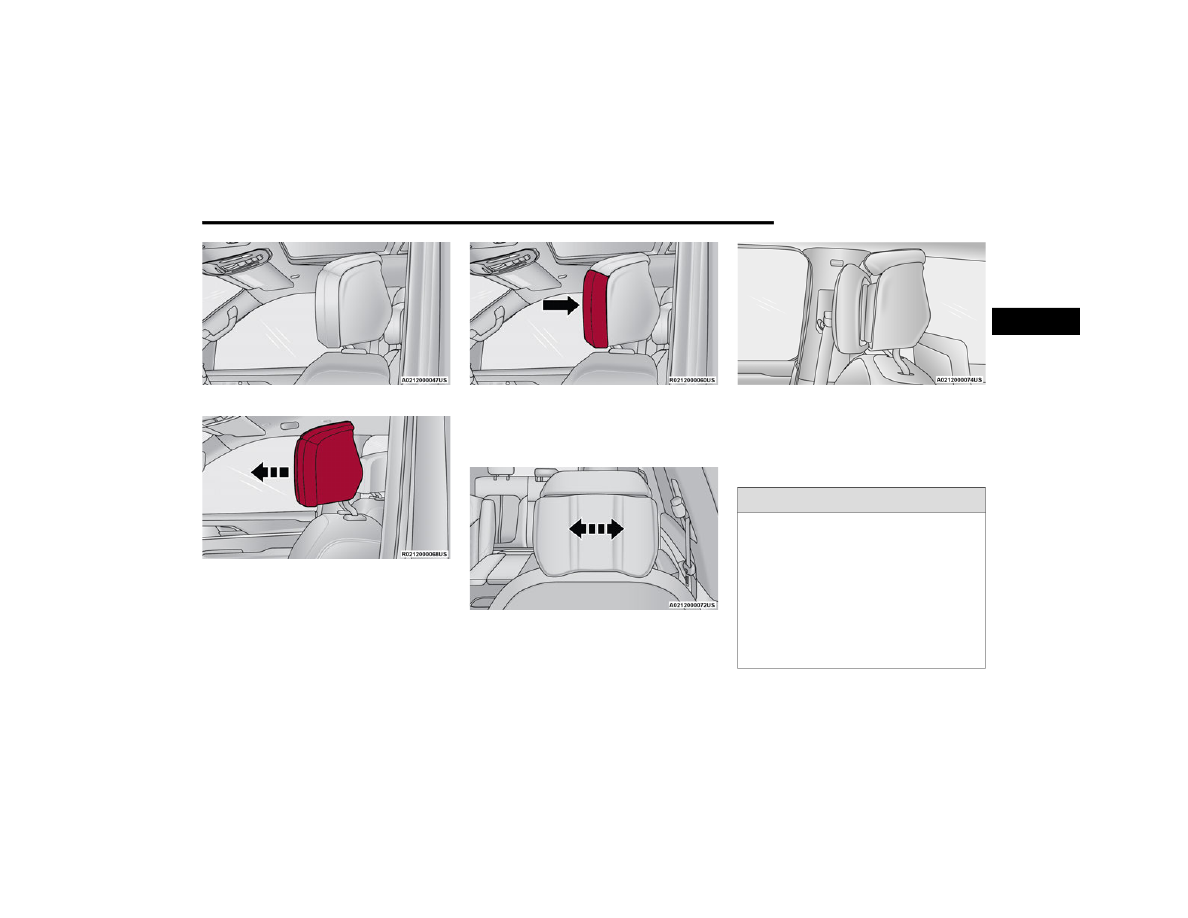
GETTING TO KNOW YOUR VEHICLE
51
Upright Position (Power Head Restraint)
Forward Adjustment (Power Head Restraint)
Grand Wagoneer front power head restraints are
also equipped with adjustable wings, located on
the outer left-hand and right-hand front face of the
head restraint.
Adjustable Wing (Left-Hand Side Shown)
To adjust the wings for additional comfort and
support, pull forward on the wings. To return the
wings, push the wings rearward to the flat position.
Wing Adjustment
Wing Extended (Left-Hand Side Shown)
NOTE:
The head restraints should only be removed by
qualified technicians, for service purposes only. If
either of the head restraints require removal, see
an authorized dealer.
WARNING!
All occupants, including the driver, should not
operate a vehicle or sit in a vehicle’s seat until
the head restraints are placed in their proper
positions in order to minimize the risk of neck
injury in the event of a crash.
Head restraints should never be adjusted
while the vehicle is in motion. Driving a vehicle
with the head restraints improperly adjusted
or removed could cause serious injury or
death in the event of a collision.
2
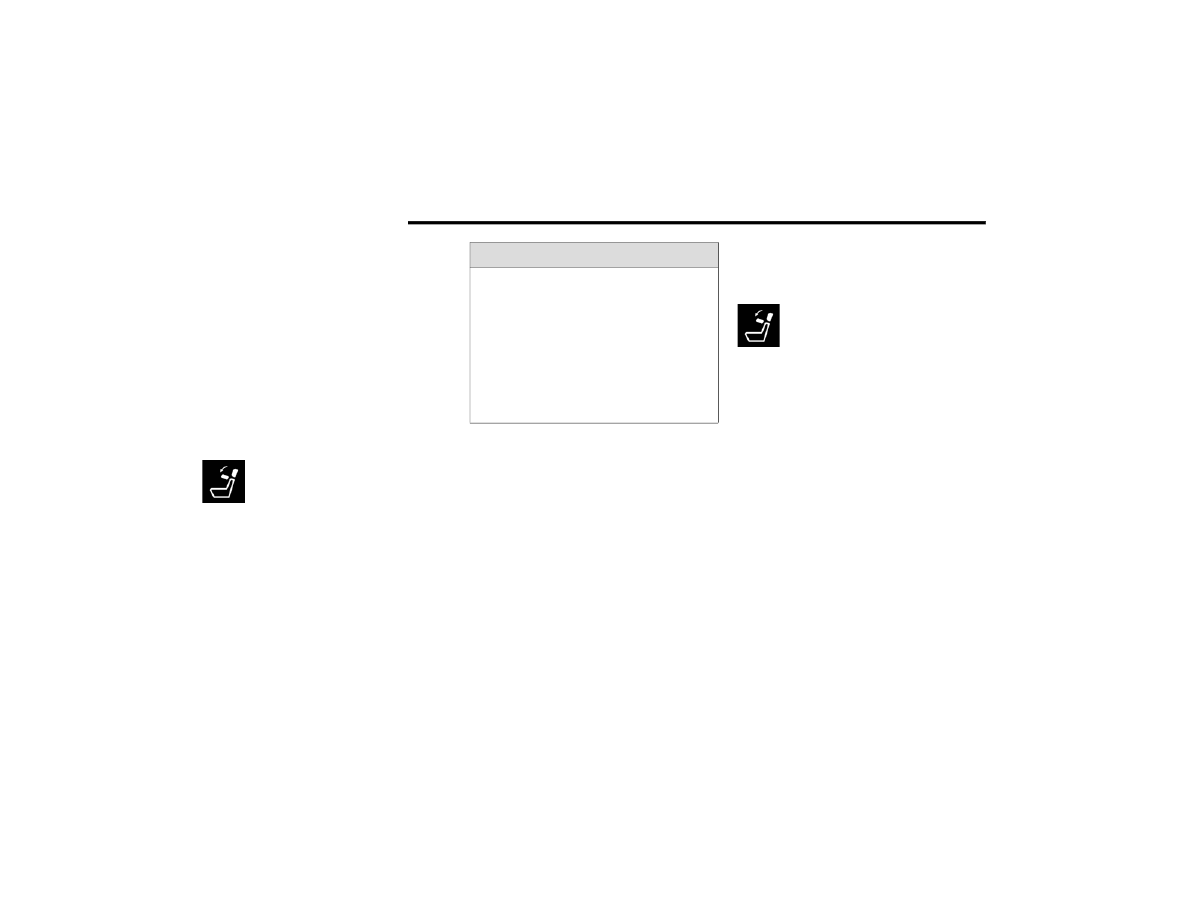
52
GETTING TO KNOW YOUR VEHICLE
Head Restraints — Second Row Captain’s
Chairs
If the second row is equipped with captain’s chairs,
the head restraints are not adjustable or
removable. They automatically fold forward when
the seatback is folded, and do not return to their
normal position when the seatback is raised. After
returning the seatback to its upright position after
a folding operation, raise the head restraint until it
locks in place.
The driver can also fold the second row outboard
head restraints through the radio, for improved
visibility when the vehicle is in REVERSE and there
are no occupants in the seats.
Press the “Headrest Fold” button within
the Controls menu of the Uconnect
system to power fold the second row
outboard head restraints.
NOTE:
The head restraints must be raised manually
when occupying the second row.
Do not fold if there are passengers seated in the
second row seats.
Head Restraints — Second Row Bench
If the second row is equipped with a bench seat,
the head restraints on the outboard seats are not
adjustable or removable. They automatically fold
forward when the seatback is folded, and do not
return to their normal position when the seatback
is raised. After returning the seatback to its upright
position after a folding operation, raise the head
restraint until it locks in place.
The driver can also fold the second row outboard
head restraints through the radio, for improved
visibility when the vehicle is in REVERSE, and there
are no occupants in the seats.
Press the “Headrest Fold” button within
the Controls menu of the Uconnect
system to power fold the second row
outboard head restraints.
NOTE:
The head restraints must be raised manually
when occupying the second row.
Do not fold if there are passengers seated in the
second row seats.
The center head restraint has one adjustment
position, and can be adjusted up, when the seat is
occupied, or down for storage. To adjust this head
restraint, push the adjustment button, located on
the base of the head restraint, while pulling
upward or pushing downward until it locks into
place.
WARNING!
All occupants, including the driver, should not
operate a vehicle or sit in a vehicle’s seat until
the head restraints are placed in their proper
positions in order to minimize the risk of neck
injury in the event of a crash.
Head restraints should never be adjusted
while the vehicle is in motion. Driving a vehicle
with the head restraints improperly adjusted
or removed could cause serious injury or
death in the event of a collision.

GETTING TO KNOW YOUR VEHICLE
53
NOTE:
The center head restraint is not removable.
Center Seat Head Restraint Adjustment Button
NOTE:
For information on child restraint tethering, see
Third Row Head Restraints
The head restraint in the center position can be
raised and lowered for tether routing or height
Center Head Restraint Adjustment Button
NOTE:
The center head restraint should only be removed
by qualified technicians, for service purposes only.
If the head restraint requires removal, see an
authorized dealer.
The third row outboard head restraints are not
adjustable or removable, but can be folded for
improved visibility when the vehicle is in REVERSE,
and there are no occupants in the seats.
Press the “Headrest Fold” button within
the Controls menu of the Uconnect
system to power fold the third row head
restraints.
The head restraints will also automatically fold
when the seatbacks are folded forward using the
release handles on the backs of the seats from the
cargo area.
NOTE:
The head restraints must be raised manually
when occupying the third row.
Do not fold if there are passengers seated in the
third row seats.
WARNING!
All occupants, including the driver, should not
operate a vehicle or sit in a vehicle’s seat until
the head restraints are placed in their proper
positions in order to minimize the risk of neck
injury in the event of a crash.
Head restraints should never be adjusted
while the vehicle is in motion. Driving a vehicle
with the head restraints improperly adjusted
or removed could cause serious injury or
death in the event of a collision.
WARNING!
All occupants, including the driver, should not
operate a vehicle or sit in a vehicle’s seat until
the head restraints are placed in their proper
positions in order to minimize the risk of neck
injury in the event of a crash.
Head restraints should never be adjusted
while the vehicle is in motion. Driving a vehicle
with the head restraints improperly adjusted
or removed could cause serious injury or
death in the event of a collision.
2
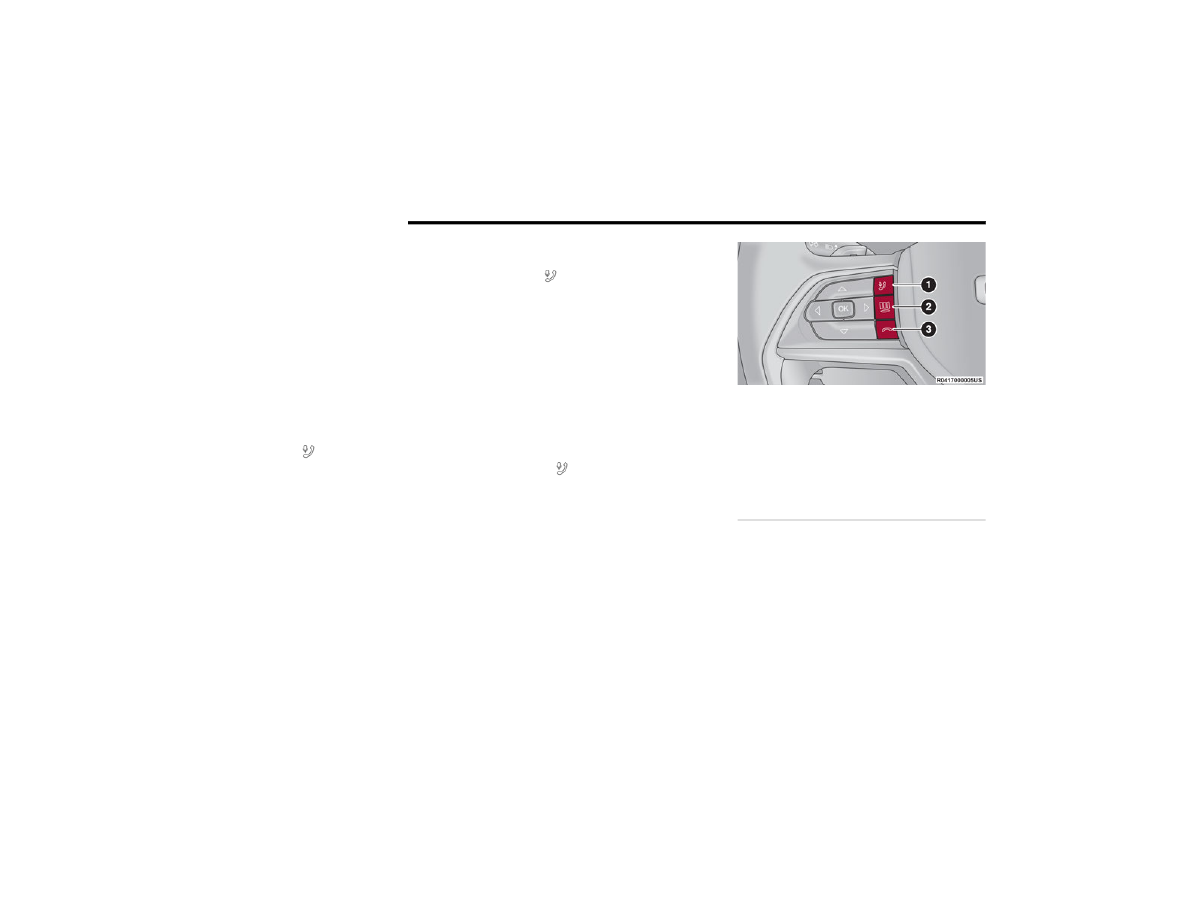
54
GETTING TO KNOW YOUR VEHICLE
UCONNECT VOICE RECOGNITION QUICK TIPS —
IF EQUIPPED
I
NTRODUCING
V
OICE
R
ECOGNITION
Start using Uconnect Voice Recognition with these
helpful quick tips. It provides the key Voice
Commands and tips you need to know to control
your vehicle’s Voice Recognition (VR) system.
B
ASIC
V
OICE
C
OMMANDS
The basic Voice Commands below can be given at
any point while using your Uconnect system.
Push the VR button , and after the beep, say a
command. You can also say the system “Wake Up”
word and then say a command:
“Cancel” to stop a current voice session.
“Help” to hear a list of suggested Voice
Commands.
“Repeat” to listen to the system prompts again.
Notice the visual cues that inform you of your Voice
Recognition system’s status.
G
ET
S
TARTED
The VR button is used to activate/deactivate
your Voice Recognition system. You can also use
the system’s “Wake Up” word to activate voice
recognition. The “Wake Up” word can be set
Helpful hints for using Voice Recognition:
Reduce background noise. Wind noise and
passenger conversations are examples of noise
that may impact recognition.
Speak clearly at a normal pace and volume
while facing straight ahead.
Each time you give a Voice Command, first push
the VR button or say the “Wake Up” word,
wait until after the beep, then say your Voice
Command.
You can interrupt the help message or system
prompts by pushing the VR button and saying a
Voice Command from the current category.
You can also interrupt the help message or
system prompts by speaking. This feature is
called “barge-in” and can be set through the
Uconnect Voice Command Buttons
1 — Push The Voice Recognition Button To Begin
Radio, Media, Navigation (If Equipped), Climate,
Start Or Answer A Phone Call, And Send Or
Receive A Text
2 — Push To Access The Tile Feature
3 — Push The Hang Up Button To End A Call
Currently In Progress

GETTING TO KNOW YOUR VEHICLE
55
A
DDITIONAL
I
NFORMATION
Uconnect are registered trademarks and Mopar
Owner Connect is a trademark of FCA US LLC.
Android™ is a trademark of Google Inc. SiriusXM®
and all related marks and logos are trademarks of
For Uconnect system support, call
1-877-855-8400 (24 hours a day 7 days a week)
or visit
(US) or
DRIVER ADJUSTABLE PEDALS
The adjustable pedals system is designed to allow
a greater range of driver comfort for steering wheel
tilt and seat position. This feature allows the brake
and accelerator pedals to move toward or away
from the driver to provide improved position with
the steering wheel.
The adjustable pedal switch is located on the
instrument panel, next to the headlight switch.
Adjustable Pedals Switch
The pedals can be adjusted with the ignition in
the OFF position.
The pedals cannot be adjusted when the vehicle
is in REVERSE or when the Cruise Control
system or Adaptive Cruise Control system is on.
If there is an attempt to adjust the pedals when
the system is locked out, the following
messages will appear:
Adjustable Pedal Disabled — Cruise Control
Engaged
Adjustable Pedal Disabled — Vehicle In
Reverse
NOTE:
Always adjust the pedals to a position that
allows full movement of the pedal.
Further small adjustments may be necessary to
find the best possible seat/pedal position.
For vehicles equipped with Driver Memory
page 35, you can use your key fob or
the memory switch on the driver’s door trim
panel to return the adjustable pedals to saved
positions.
WARNING!
Do not adjust the pedals while the vehicle is
moving. You could lose control and have an
accident. Always adjust the pedals while the
vehicle is parked.
CAUTION!
Do not place any article under the adjustable
pedals or impede its ability to move, as it may
cause damage to the pedal controls. Pedal
travel may become limited if movement is
stopped by an obstruction in the adjustable
pedal's path.
2

56
GETTING TO KNOW YOUR VEHICLE
MIRRORS
I
NSIDE
R
EARVIEW
M
IRROR
Manual Mirror — If Equipped
The mirror head can be adjusted up, down, left,
and right. The mirror should be adjusted to center
on the view through the rear window.
Headlight glare from vehicles behind you can be
reduced by moving the small control under the
mirror to the night position (toward the rear of the
vehicle). The mirror should be adjusted while set in
the day position (small control forward toward the
windshield).
Adjusting Rearview Mirror
Automatic Dimming Mirror — If Equipped
The mirror head can be adjusted up, down, left,
and right. The mirror should be adjusted to center
on the view through the rear window.
This mirror automatically adjusts for headlight
glare from vehicles behind you.
NOTE:
The Automatic Dimming Mirror feature is disabled
when the vehicle is in REVERSE to improve the
driver’s view.
You can turn the feature on or off through the
Automatic Dimming Mirror
Digital Rearview Mirror — If Equipped
The Digital Rearview Mirror provides a high
definition, wide and unobstructed view of the road
behind while driving.
Position the mirror in the regular Automatic
Dimming Mirror mode, then activate the Digital
Rearview Mirror mode.
To activate the Digital Rearview Mirror, pull the on/
off control lever on the bottom of the mirror
rearward toward the driver.
Digital Rearview Mirror
Push the menu button next to the on/off control/
toggle to access the following mirror options:
Brightness
Tilt
Use the left and right buttons to scroll through
menu options.
1 — On/Off Control/Toggle
2 — Menu Button
3 — Left Scroll Button
4 — Right Scroll Button
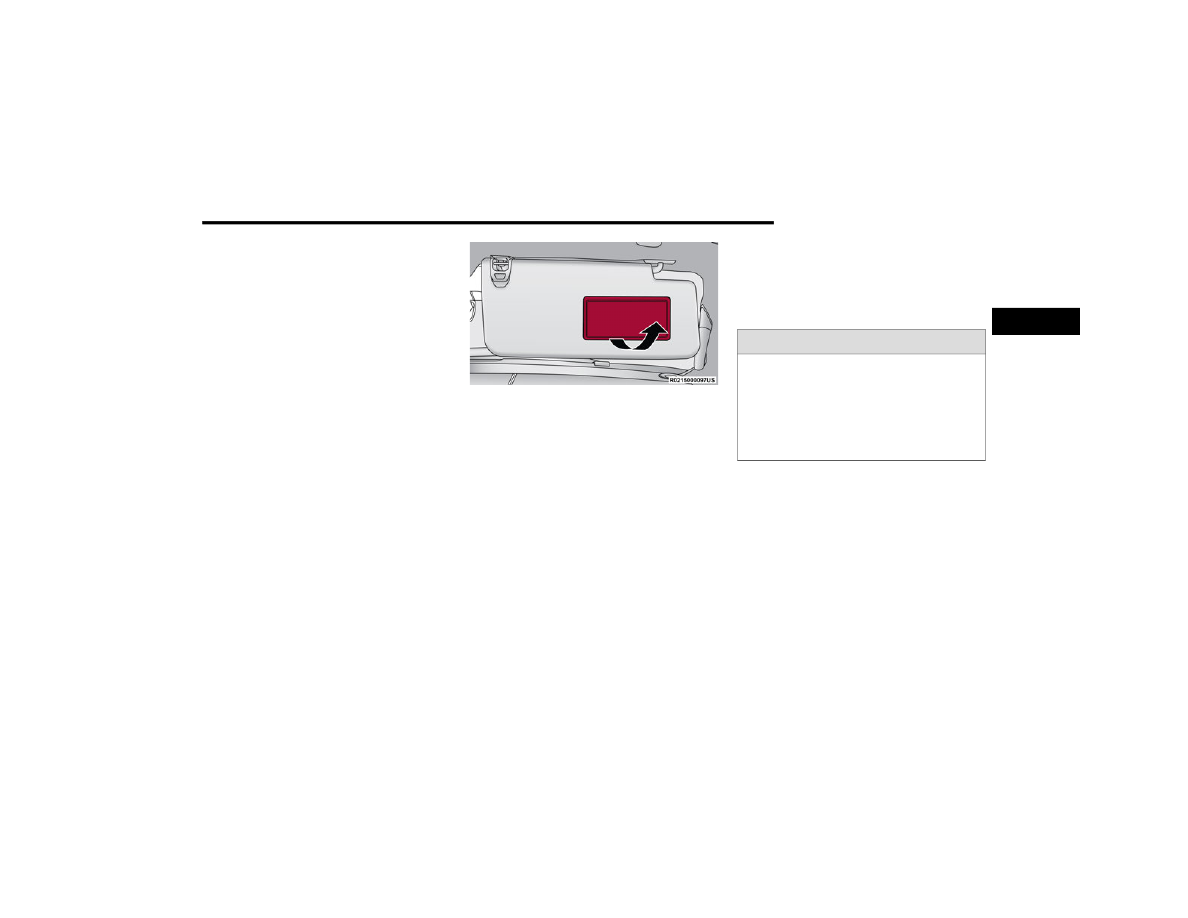
GETTING TO KNOW YOUR VEHICLE
57
When not in use, push the on/off forward toward
the windshield to return the mirror to the regular
Automatic Dimming Mirror.
NOTE:
The Digital Rearview Mirror is not as effective
during nighttime driving in low light applications
due to low ambient light levels. In the event that
it provides the user with less than expected
vision, the mirror can be reverted to a normal
reflective Automatic Dimming Mirror by pushing
the control/toggle forward in the vehicle and
putting the mirror into Automatic Dimming
Mirror mode.
When the rear window washer is activated by
pushing the windshield wiper/washer lever
forward, the rear backup and digital rearview
mirror (if equipped) cameras are also washed.
I
LLUMINATED
V
ANITY
M
IRRORS
To access an illuminated vanity mirror, flip down
one of the visors.
Lift the cover to reveal the mirror. The light will turn
on automatically.
Lift Cover On Vanity Mirror
Sun Visor “Slide-On-Rod” Feature —
If Equipped
The sun visor “Slide-On-Rod” feature allows for
additional flexibility in positioning the sun visor to
block out the sun.
1. Fold down the sun visor.
2. Unclip the visor from the center clip.
3. Pivot the sun visor toward the side window.
4. Extend the sun visor blade for additional sun
blockage.
NOTE:
The sun visor blade can also be extended while the
sun visor is against the windshield for additional
sun blockage through the front of the vehicle.
O
UTSIDE
M
IRRORS
To receive maximum benefit, adjust the outside
mirror(s) to center on the adjacent lane of traffic
with a slight overlap of the view obtained on the
inside mirror.
Outside Mirrors Folding Feature
All outside mirrors are hinged and may be moved
either forward or rearward to resist damage. The
hinges have three detent positions:
Full forward position
Full rearward position
Normal position
WARNING!
Vehicles and other objects seen in an outside
convex mirror will look smaller and farther away
than they really are. Relying too much on side
convex mirrors could cause you to collide with
another vehicle or other object. Use your inside
mirror when judging the size or distance of a
vehicle seen in a side convex mirror.
2
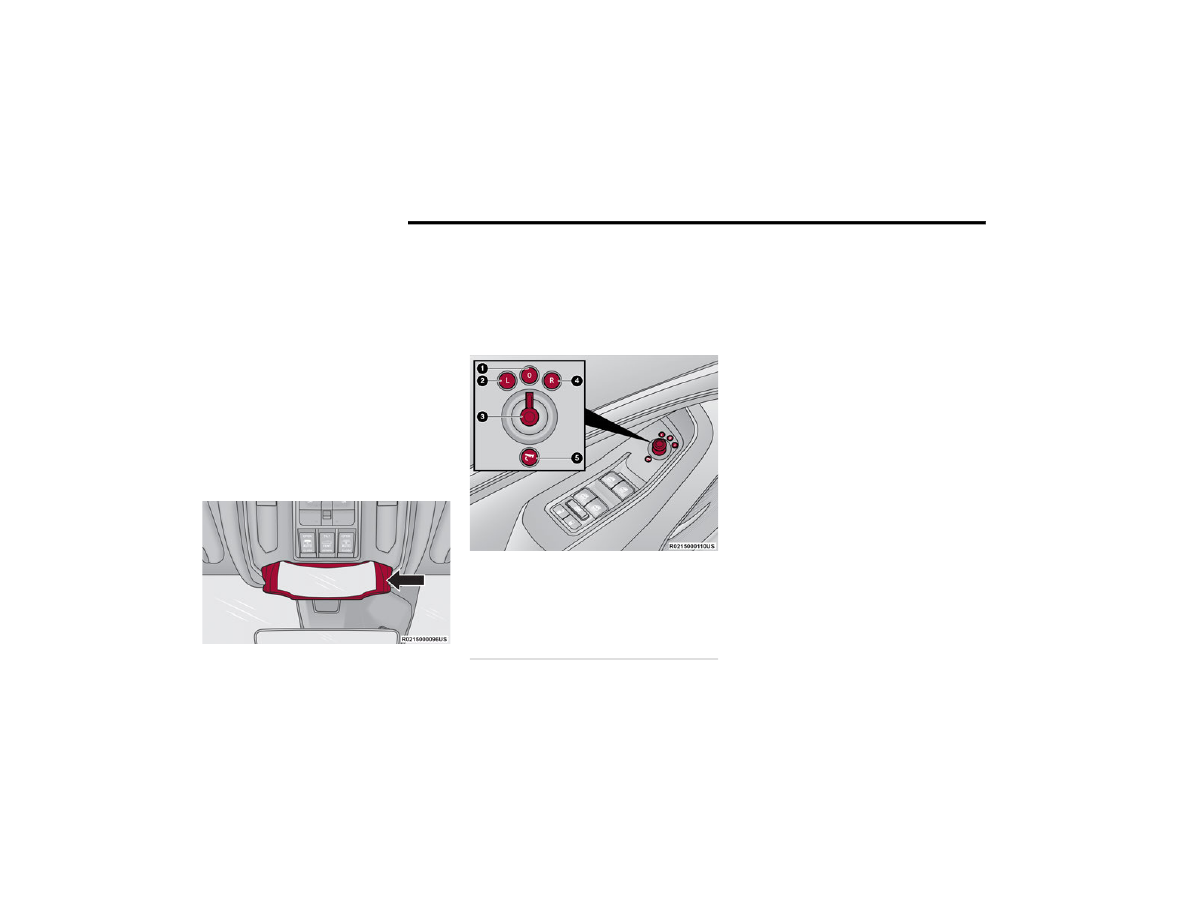
58
GETTING TO KNOW YOUR VEHICLE
O
UTSIDE
A
UTOMATIC
D
IMMING
M
IRRORS
— I
F
E
QUIPPED
The outside mirrors will automatically adjust for
glare from vehicles behind you. This feature is
controlled by the inside automatic dimming mirror.
The mirrors will automatically adjust for headlight
glare when the inside mirror adjusts.
C
ONVERSATION
M
IRROR
Located in the overhead console there is a
conversation mirror to view all of the passengers in
the vehicle. Push the panel to release the drop
down mirror, raise it back up to 3/4th of the way
and let go, a latch will hold the mirror in place.
Raise the mirror all the way and push to latch it
back in the stowed position.
Conversation Mirror
P
OWER
M
IRRORS
The power mirror control switch is located on the
driver's side door trim panel.
To adjust a mirror, rotate the control switch to the
desired mirror: (L) or (R). Then push the switch in
the direction that you want the mirror to move.
Power Mirror Switch
NOTE:
Once adjustment is complete, rotate the knob to
the neutral position to prevent accidental move
-
ments.
Power Folding — If Equipped
To fold the door mirrors in using the Power Folding
Mirror function, rotate the control switch to the
power folding position. Rotating the control to the
left, right, or neutral position will return the mirrors
to the driving position.
If the power mirror control switch is moved again
during door mirror folding (from closed to open
position and vice versa), the movement direction is
reversed.
Resetting The Power Folding Outside Mirrors
You may need to reset the power folding mirrors if
the following occurs:
The mirrors are accidentally blocked while
folding.
The mirrors are accidentally manually folded/
unfolded (by hand or by pushing the power
folding mirror switch).
The mirrors come out of the unfolded position.
The mirrors shake and vibrate at normal driving
speeds.
1 — Neutral Position
2 — Left Mirror
3 — Control Switch
4 — Right Mirror
5 — Power Folding Position (If Equipped)
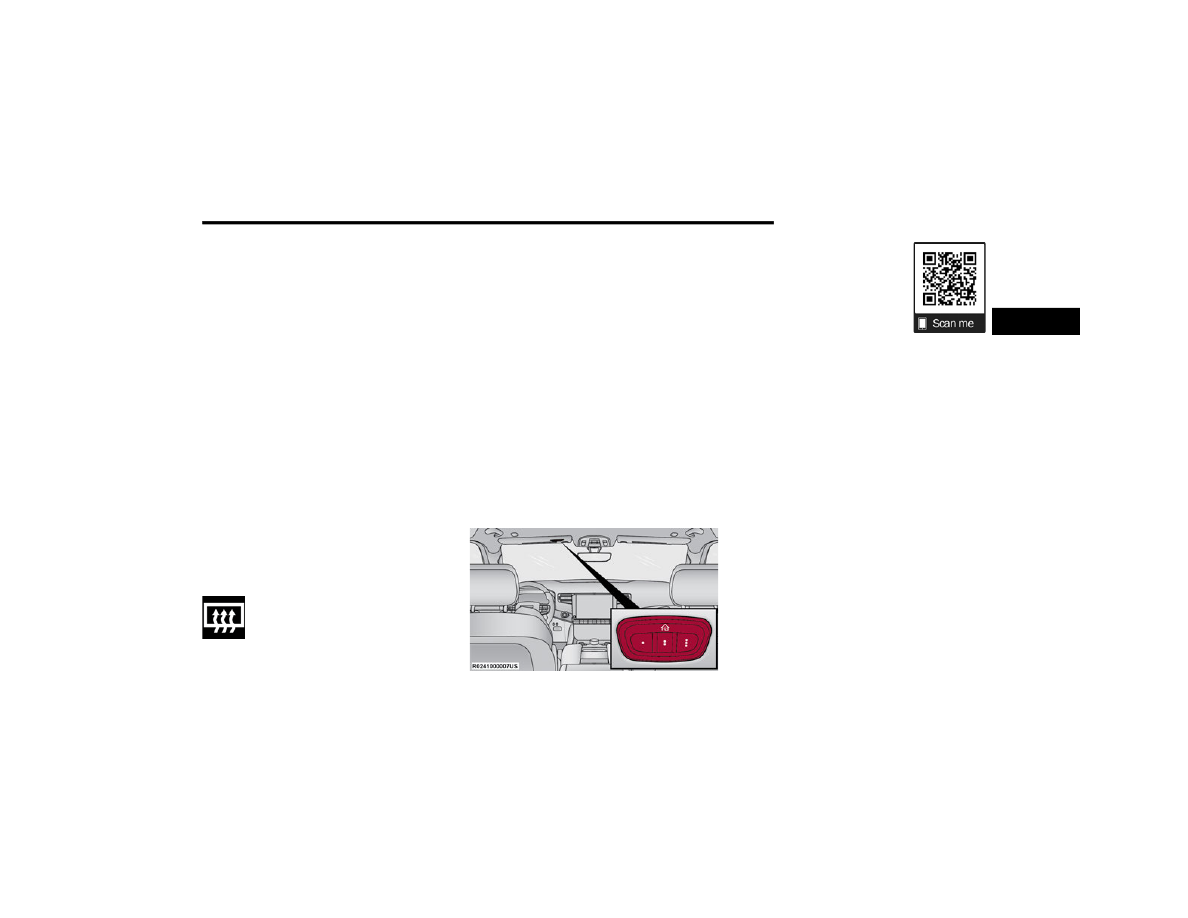
GETTING TO KNOW YOUR VEHICLE
59
To reset the power folding mirrors: Fold and unfold
them by turning the switch (this may require
multiple switch activations to synchronize the
driver and passenger mirror). This resets them to
their normal position.
Power mirror position can be saved as part of the
Driver Memory Settings (if equipped)
A
UTOMATIC
P
OWER
F
OLDING
M
IRRORS
—
I
F
E
QUIPPED
When enabled within Uconnect Settings
page 216, the exterior mirrors will automatically
fold when the ignition is placed in the OFF position
while all doors are still closed and locked.
If the exterior mirrors were folded automatically,
they will unfold when the unlock button on the key
fob is pushed.
NOTE:
If the mirrors were folded manually, by using the
power folding mirror switch on the driver’s door
panel, they will not automatically unfold.
H
EATED
M
IRRORS
These mirrors are heated to melt frost or
ice. This feature will be activated
whenever you turn on the rear window
T
ILT
S
IDE
M
IRRORS
I
N
R
EVERSE
Tilt Side Mirrors In Reverse provides automatic outside
mirror positioning which will aid the driver’s view of the
ground rearward of the front doors. Outside mirrors will
move slightly downward from the present position
when the vehicle is shifted into REVERSE. Outside
mirrors will then return to the original position when the
vehicle is shifted out of REVERSE position. Each stored
memory setting will have an associated Tilt Side Mirrors
In Reverse position.
NOTE:
The Tilt Side Mirrors In Reverse feature can be
turned on and off using the Uconnect system
UNIVERSAL GARAGE DOOR OPENER
(HOMELINK®)
HomeLink® Buttons And Indicator Light
Use this QR code to access your
digital experience.
HomeLink® replaces up to
three hand-held transmitters
that operate devices such as
garage door openers, motor
-
ized gates, lighting or home
security systems. The HomeLink® unit is
powered by your vehicle’s 12 Volt battery.
The HomeLink® buttons that are located in the
overhead console or sunvisor designate the
three different HomeLink® channels.
To operate HomeLink®, push and release any
of the programmed HomeLink® buttons. These
buttons will activate the devices they are
programmed to with each press of the corre
-
sponding HomeLink® button.
The HomeLink® indicator light is located above
the center button.
NOTE:
HomeLink® is disabled when the Vehicle Security
B
EFORE
Y
OU
B
EGIN
P
ROGRAMMING
H
OME
L
INK
®
For efficient programming and accurate
transmission of the Radio Frequency (RF) signal, it
is recommended that a new battery be placed in
the hand-held transmitter of the device that is
2
60
GETTING TO KNOW YOUR VEHICLE
being programmed to the HomeLink® system.
Make sure your hand-held transmitter is
programmed to activate the device you are trying
to program your HomeLink® button to.
Ensure that your vehicle is parked outside of the
garage before you begin programming.
It is recommended that you erase all the channels
of your HomeLink® before you use it for the first
time.
E
RASING
A
LL
T
HE
H
OME
L
INK
®
C
HANNELS
To erase the channels, follow this procedure:
1. Place the ignition switch into the ON/RUN
position.
2. Push and hold the two outside HomeLink®
buttons (I and III) for up to 20 seconds, or until
the HomeLink® indicator light flashes.
NOTE:
Erasing all channels should only be performed
when programming HomeLink® for the first time.
Do not erase channels when programming addi
-
tional buttons.
I
DENTIFYING
W
HETHER
Y
OU
H
AVE
A
R
OLLING
C
ODE
O
R
N
ON
-R
OLLING
C
ODE
D
EVICE
Before programming a device to one of your
HomeLink® buttons, you must determine whether
the device has a rolling code or non-rolling code.
Rolling Code Devices
To determine if your device has a rolling code, a
good indicator is its manufacturing date. Typically,
devices manufactured after 1995 have rolling
codes. A device with a rolling code will also have a
“LEARN” or “TRAIN” button located where the
antenna is attached to the device. The button may
not be immediately visible when looking at the
device. The name and color of the button may vary
slightly by manufacturer.
NOTE:
The “LEARN” or “TRAIN” button is not the button
you normally use to operate the device.
Non-rolling Code Devices
Most devices manufactured before 1995 will not
have a rolling code. These devices will also not
have a “LEARN” or “TRAIN” button.
P
ROGRAMMING
H
OME
L
INK
® T
O
A
G
ARAGE
D
OOR
O
PENER
To program any of the HomeLink® buttons to
activate your garage door opener motor, follow the
steps below:
NOTE:
All HomeLink® buttons are programmed using this
procedure. You do not need to erase all channels
when programming additional buttons.
1. Place the ignition switch into the ON/RUN
position.
2. Place the garage door opener transmitter 1 to
3 inches (3 to 8 cm) away from the
HomeLink® button you wish to program, while
keeping the HomeLink® indicator light in view.
3. Push and hold the HomeLink® button you
want to program while you push and hold the
garage door opener transmitter button you are
trying to replicate.
4. Continue to hold both buttons and observe the
HomeLink® indicator light. The HomeLink®
indicator light will flash slowly and then rapidly.
Once this happens, release both buttons.
NOTE:
Make sure the garage door opener motor is
plugged in before moving on to the rolling code/
non-rolling code final steps.

Нет комментариевНе стесняйтесь поделиться с нами вашим ценным мнением.
Текст